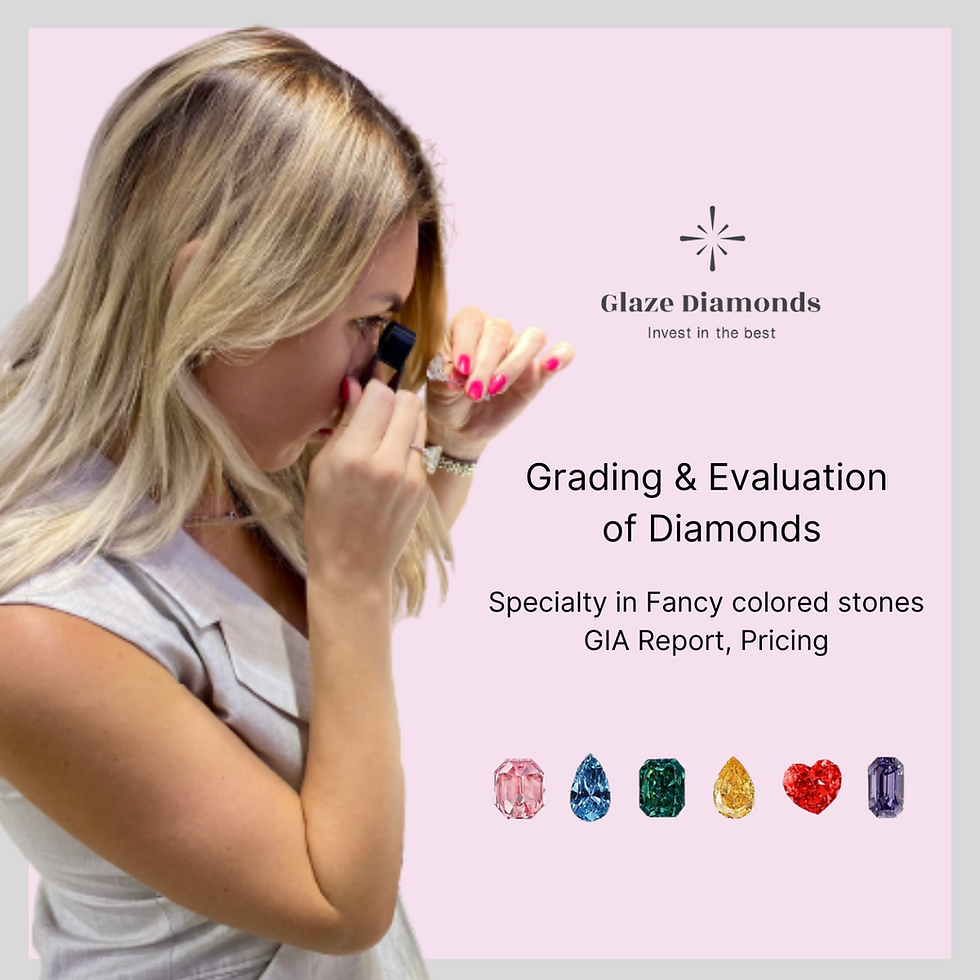How Diamonds Get Their Colour
- Tom Maughan

- Apr 15, 2019
- 4 min read
A Diamond is a solid form of the element carbon with its atoms arranged in a crystal structure called diamond cubic.
Density: 3.51 g/cm³
Mohs scale hardness: 10 (defining mineral)
Most natural diamonds are formed at high temperature and pressure at depths of 140 to 190 kilometers (87 to 118 mi) in the Earth’s mantle. Carbon-containing minerals provide the carbon source, and the growth occurs over periods from 1 billion to 3.3 billion years (25% to 75% of the age of the Earth). Diamonds are brought close to the Earth’s surface through deep volcanic eruptions by a magma, which cools into igneous rocks known as kimberlites and lamproites. Diamonds can also be produced synthetically in a HPHT method which approximately simulates the conditions in the Earth’s mantle. An alternative, and completely different growth technique is chemical vapor deposition (CVD). Several non-diamond materials, which include cubic zirconia and silicon carbide and are often called diamond simulants, resemble diamond in appearance and many properties. Special gemological techniques have been developed to distinguish natural diamonds, synthetic diamonds, and diamond simulants.
Beyond the better known colourless diamonds a huge range of colours exists. Varying between grey, blue, yellow, orange, red, green and pin/purple. Coloured diamonds contain impurities or defects that cause the coloration. Formed over millions of years in the earth’s crust, the presence of other atoms in addition to carbon creates a varied range of coloured diamonds, often with the presence of multiple colours.
Orange Diamonds

Whilst the vast majority of diamonds contain some nitrogen due to the presence of carbon vacancies explained above, with Orange diamonds the nitrogen atoms have grouped themselves in a particular way, right after the diamond has been formed. The nitrogen arrangements then absorb light from the blue and yellow regions of the spectrum to produce and often vivid orange colour. Interest in the colour surged in 1997 after the auction of the pumpkin diamond, famously named by the buyer after he purchased the day before Halloween.
Yellow Diamonds

As with the orange diamond, in the creation of the yellow diamond the Nitrogen atoms present have formed themselves in a particular way, right at the creation point of the diamond. The particular arrangements of the nitrogen atoms within the diamond allow absorption of light from the blue region of the light spectrum, but importantly not the yellow region as is the case with the orange diamond. The largest and most vivid in colour of the yellow diamonds originate in South Africa.
Green Diamonds

Green diamonds gain their colour due to exposure to naturally occurring radiation upon their journey to the earth's surface. The radiation penetrates the carbon atoms within the diamond causing them to absorb primarily red and green from the light spectrum. Green diamonds are found mainly in Africa and South America, with the Dresden Green being the most famous of them all.
Blue Diamonds

As with all coloured diamonds, the absorption of light is key to defining the colour of the diamond. With Blue Diamonds the presence of Boron and the creation of the diamond causing a bond with the carbon atoms that naturally absorbs red, yellow and green from the light spectrum. Blue diamonds are most commonly extracted in South Africa and India, the mos famous of them all is the 45 carat Hope Diamond.
Pink Diamonds

Diamonds become pink when heat and pressure deep within the earth's crust cause the crystal lattice to distort. These distortions cause Pink Diamonds to absorb green light from the spectrum and hence display a pink colour. Pink diamonds can be found in Brazil, Russia, Siberia, South Africa, Tanzania and Canada. However, the majority of the rarer stones hail from the Argyle Mine in Australia.
Red Diamonds

Red diamonds are very rare and they are actually very strongly and deeply coloured pink diamonds, with the same cause of colour and crystal distortion. This combination is so rare that most jewellers and diamond dealers have never even seen a natural red diamond. They do not get large with the 5.11 carat Moussiaf Redshield being the largest known red diamond in the world.
Purple Diamonds

Purple diamonds as with the pink diamond are very rare and are understood to be created in the same way, through crystal distortion. Purple diamonds are usually found in Siberia and are generally very small with ones larger than 5 carats being extremely rare, as a result there are no purple diamonds with a rich history and fame.
Black Diamonds

Natural black diamonds are again very rare and unlike other coloured diamonds with geological impurities such as nitrogen, hydrogen and boron, raw black diamonds owe their colour to the inclusion of graphite and random clustering throughout the diamond, typically graphite. The black diamond is found in very few places around the world, with Brazil and central Africa being the better known locations. It is rare that they are large, but the most famous black diamond, the Black Orloff, is 67.50 carats.
Brown Diamonds

Brown diamonds are the most common of the coloured diamonds, accounting for over 15% of output in most mines. Irradiation of diamonds by high energy particles creates vacancies within the diamond lattice by ejecting carbon atoms. Those vacancies coupled with extreme temperatures of over 600 degrees Celsius then causes aggregation to the vacancies and the presence of brown colour. The brown colour of diamonds makes them less attractive and they are therefore often used primarily for industrial purposes.





Comments